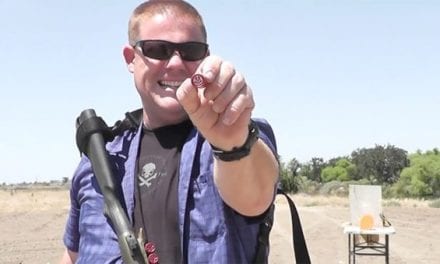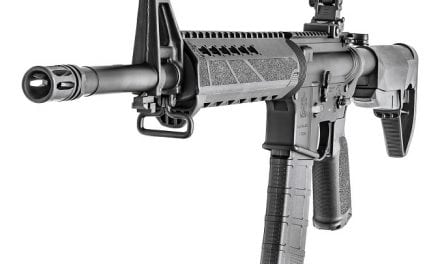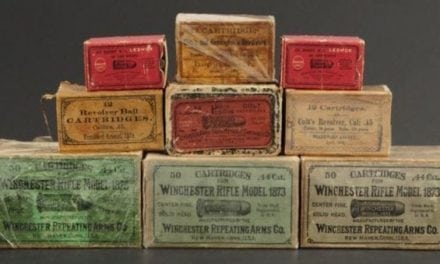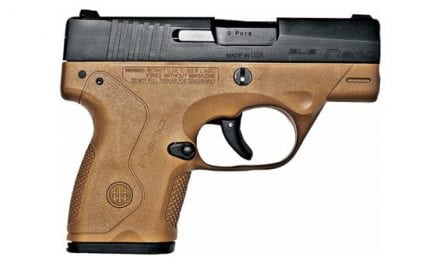by Charles R. Drago, Editor, OEL Magazine
The Gatling gun was born in a storm of irony. It was designed by the American Dr. Richard J. Gatling in 1861 and patented a year later. Gatling repeatedly reminded all who would listen that he created the gun to save lives by reducing the size of armies while ultimately demonstrating the futility of war.
The earliest Gatling gun model was capable of continuous fire, yet because it required a person to crank it, it was not technically an automatic weapon.
The Gatling gun’s innovative design included a cyclic multi-barrel which resulted in all-important cooling and allowed for a synchronized firing/reloading sequence. Each barrel fired a single shot when it reached a certain point in the cycle; it then ejected the spent cartridge, loaded a new round, and ensured barrel cooling. This configuration allowed higher rates of fire – 200 rounds per minute – without the barrels overheating.

The Gatling gun was operated by turning a heavy hand-crank. As many as ten barrels revolved around a central shaft. The shaft rotated in response to cranking. The carrier was grooved and the lock cylinder was drilled with holes corresponding to the barrels.
Cartridges, held in a hopper, dropped individually into the grooves of the carrier. The lock was simultaneously forced by the cam to move forward and load the cartridge, and when the cam was at its highest point, the cocking ring freed the lock and fired the cartridge. After the cartridge was fired the continuing action of the cam drew back the lock bringing with it the spent cartridge which then dropped to the ground.
Early generations of Gatlings approached the size and weight of artillery pieces, and were often perceived as a replacement for cannons firing grapeshot or canister shot.
The Gatling gun was first used in combat during the American Civil War. The Army would not accept the weapon until 1866, but the advantages inherent in the gun were not lost on officers. Twelve Gatling guns were purchased by Union commanders and used in the trenches during the siege of Petersburg, Virginia. Eight other Gatling guns were installed on gunboats.
It was reported that in July, 1863, Gatling guns were used against peaceful civilian demonstrators, including anti-draft “rioters” in New York and striking workers in Philadelphia – not precisely the purpose envisioned by Dr. Gatling when he designed the weapon.
Of some historical interest is the fact that General George Armstrong Custer declined to include a Gatling gun battery on what would be his final march – the one that culminated in the destruction of his command at Little Bighorn on June 25, 1876. How might multiple Gatlings have impacted the course of events we now refer to as “Custer’s last stand”? The jury remains out.
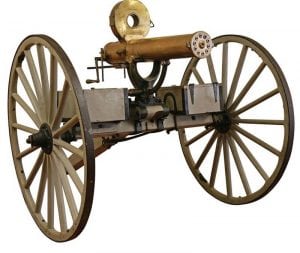
Certainly Custer might have changed his attack to set up a Gatling firing position on a ridge overlooking the huge village just across the river. Sustained fire into a camp harboring hundreds of Native American women and children very well may have forced a quick surrender by combatants in order to save the lives of their families.
On the other hand, Lakota (Sioux) and Sheyela (Cheyenne) warriors in overwhelming numbers could have flanked the heavy, difficult to maneuver Gatlings and made quick work of the gunners who stood as easy targets.
Custer’s decision to eschew the Gatlings was based on the expectation that they would slow down his march. Such a development very well may have staved off disaster; a 24-hour delay in Custer’s arrival would have resulted in a better chance for coordination and rendezvous with another large column approaching from the north.
Dr. Gatling eventually selected a paper cartridge round charged with black powder and primed with a percussion cap. Brass cartridges came into use in the 1860s. By 1886, the gun was capable of firing more than 400 rounds per minute.
Today, variations on the basic Gatling gun configuration play vital roles in military operations, most notably as defensive shipboard weapons that can take out incoming missiles traveling at supersonic speed.
The collectability of early Gatling gun models was recently demonstrated on the television series “Pawn Stars” episode in which a pristine example was priced in excess of $300,000.












